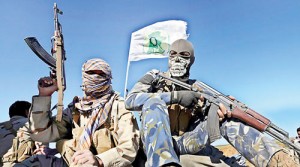Sunday Times 2
Breaking a decades-long trend, the world gets more violent
If you were watching the news last year, it was hard to escape the impression the world was falling apart. Now the data is in. And yes, it turns out the world’s most violent conflicts got a lot bloodier in 2014 – almost 30 per cent bloodier, in fact.
According to an analysis of data from the world’s 20 most lethal wars last year, at least 163,000 people died in conflict. That compares to just under 127,000 in the 20 worst wars the previous year, a rise of 28.7 percent.

Masked Shi’ite fighters hold their weapons in Al Hadidiya, Iraq on March 6, 2015. Reuters/Thaier Al-Sudani
That’s a pretty disturbing spike by anyone’s terms. And if you look at the first few months of 2015, the violence doesn’t seem to be waning.
What’s even more worrying is that this seems to be part of an ongoing trend that now goes back eight years. According to the Australia-based Institute for Economics and Peace (IEP), global violence – as defined by a range of measures from conflict deaths, to displaced persons, to homicide rates – has been rising since 2007.
This news is in many ways surprising because up to 2007, the data suggested the world was becoming a much safer place.
According to the IEP, global violence had been broadly subsiding since the end of World War Two. Harvard psychologist StevenPinker traces it back even further. Since the dawn of prehistory, Pinker’s research suggests, mankind has been becoming less violent.
So what is going wrong now? And how bad could it all get?
Conflicts in Syria, Iraq and Afghanistan, not surprisingly, top the list of highest casualties, with their confrontations with Islamic State and Taliban – as well as, of course, the ongoing fight in Syria between government and opposition supporters. Nigeria’s battle with Boko Haram has sent it rocketing up the list to number four. If Sudan and South Sudan had remained united, their combined death toll would push them to the number three spot, above Afghanistan.
Of course, all this data shows is that a handful of the world’s more violent war zones are getting worse. In the developed world, by contrast, death by violence continues to fall. Indeed, British crime statistics have continued to slump despite a recession and fewer police officers.
Even within the larger wars, an increasingly small group of people – particularly the members of elements like ISIS or Boko Haram – are doing a larger amount of killing. While 20th century wars saw much of the general (male) population mobilised and fighting, today more people seem content to sit on the sidelines.
A significant and growing percent of the population in many countries feels disenfranchised and sidelined by the way the world is developing. As the Arab Spring showed, sometimes that sentiment is reflected in largely peaceful, pro-democratic action, but sometimes it isn’t.
Eight years into the global financial crisis, the rise of nationalism many feared now seems to be showing itself. In Ukraine in particular, great powers are involved in proxy conflicts with massive repercussions for those living nearby.
Added to that, some experts warn, climate shifts are contributing to the rise in violence. In Sudan, for example, changes in grazing habits and territories are at the root of at least some of the recent violence.
Yet even with the recent spike, things aren’t as bad as they were in the 1990s, when conflicts in Africa, the Balkans and elsewhere were killing tens if not hundreds of thousands of people a year. Geographically, today’s violence is very patchy. The countries I’ve highlighted reflect a relatively small proportion of the world’s surface or population.
Hopefully, things will start to improve. Already, there are promising signs that the fight is turning against ISIS in Iraq and Syria. Even as those regions begin to stabilize, however, other countries such as Libya appear to collapse further into chaos.
What the U.S. and its allies can or should do remains entirely unclear. It’s hard to escape the awkward detail that many of the countries with the highest death tolls are those where the U.S. has made the strongest effort to shape events.
But we have to find a way of turning it around, somehow. And we’ve come a long way, after all. We don’t want to go back to battering each other to death with rocks.
Courtesy Project for Study of the 21st Century (PS21). www.projects21.com

